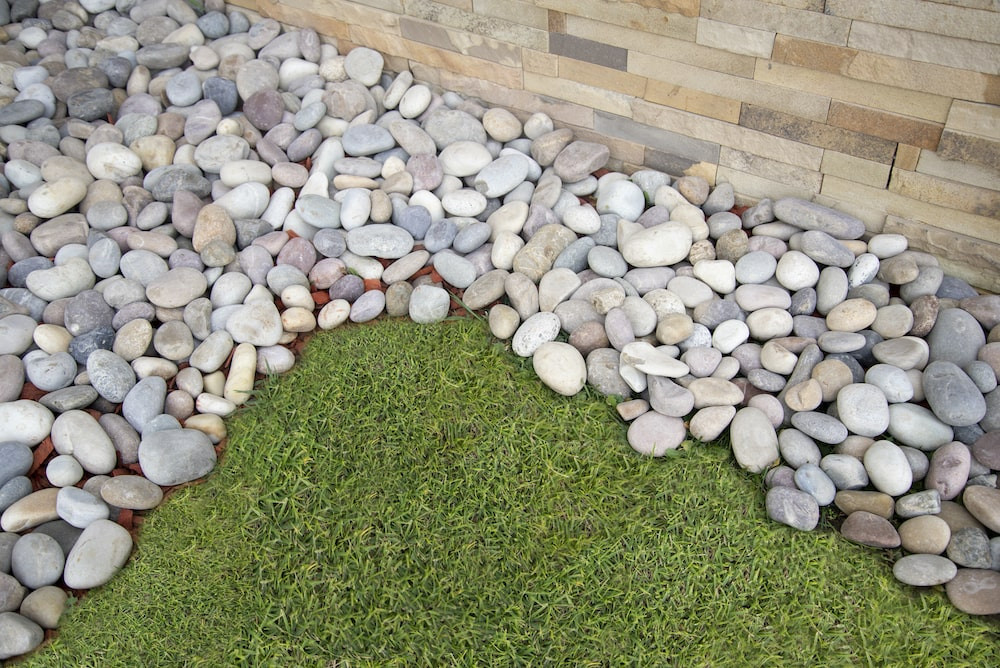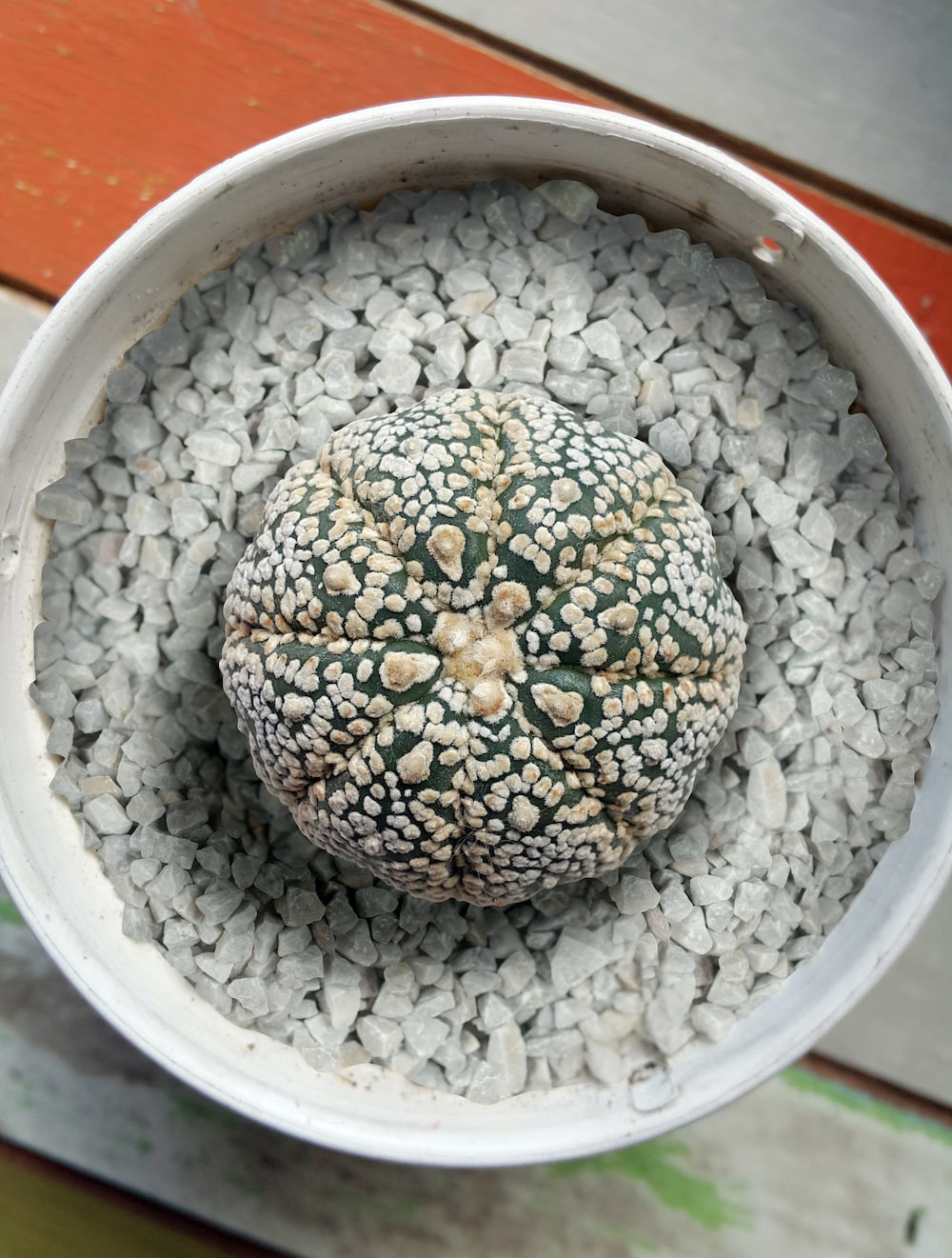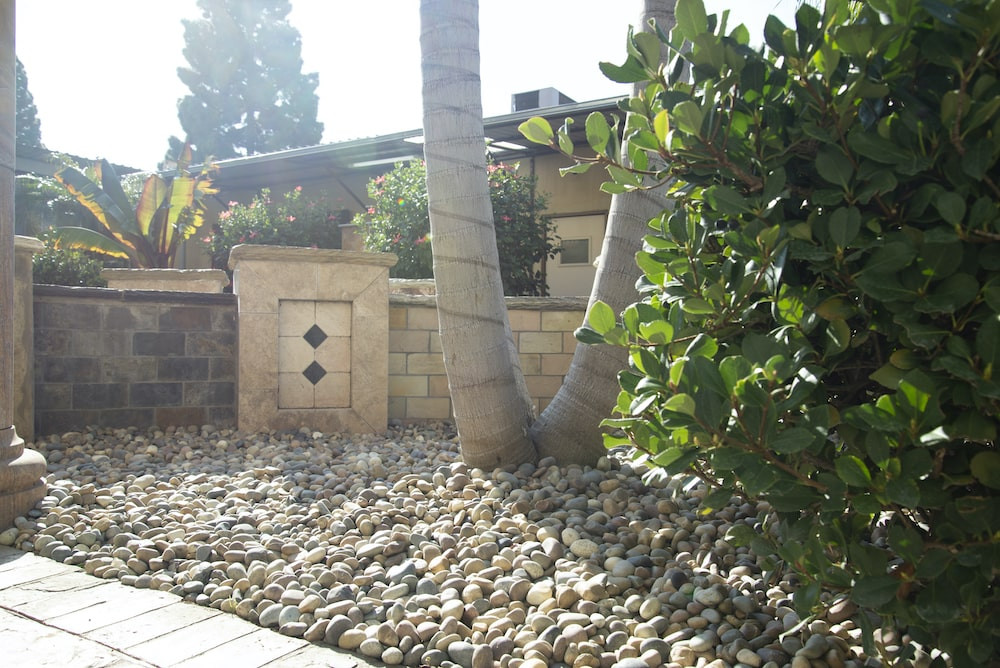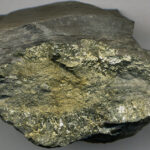Are Rocks Good For Flower Beds? Absolutely! Rocks can be a fantastic addition to your flower beds, providing aesthetic appeal, practical benefits, and long-term cost savings. At rockscapes.net, we believe that incorporating rocks into your landscape design can transform your outdoor space into a stunning and sustainable environment. Discover how decorative stones, gravel, and other rock features can enhance your garden while offering erosion control, weed suppression, and low maintenance solutions.
1. What Are The Primary Advantages Of Using Rocks In Flower Beds?
Rocks in flower beds offer durability, design versatility, and erosion control. They last for years without needing replacement, provide countless aesthetic options, and help keep soil in place.
Rocks offer several key advantages when used in flower beds. First and foremost, their durability is unmatched. Unlike organic mulches that decompose and need regular replacement, rocks can last for many years, even decades, with minimal upkeep. This longevity translates to long-term cost savings and reduced maintenance efforts. Additionally, rocks provide excellent drainage and help to prevent soil erosion, making them ideal for gardens in areas with heavy rainfall or sloped landscapes. Finally, rocks can act as a natural weed barrier, suppressing weed growth and reducing the need for herbicides.
1.1 Durability and Longevity
Rocks, unlike mulch, do not decompose and can withstand harsh weather conditions for many years. This makes them a cost-effective and sustainable choice for flower beds, requiring minimal replacement and reducing long-term expenses. According to the U.S. Department of Agriculture (USDA), inorganic mulches like rocks can last indefinitely, providing a stable and consistent ground cover.
1.2 Design Versatility
Garden rocks come in various shapes, sizes, colors, and textures, offering endless design possibilities. Whether you prefer the rustic look of river rock or the modern appeal of polished pebbles, you can create unique and visually appealing flower beds that complement your home’s architecture and personal style. At rockscapes.net, you’ll find inspiration for integrating different types of rocks into your landscape design.
 msi-amazon-multi-pebbles-ground-cover-min
msi-amazon-multi-pebbles-ground-cover-min
1.3 Erosion Control
Rocks help stabilize the soil and prevent erosion, especially in sloped areas or regions with heavy rainfall. By creating a protective layer on the soil surface, rocks minimize soil displacement and runoff, preserving the integrity of your flower beds and preventing damage to surrounding areas. Studies from Arizona State University’s School of Earth and Space Exploration show that rock mulches significantly reduce soil erosion compared to bare soil or organic mulches.
1.4 Weed Suppression
Rocks can act as a natural barrier to weed growth by blocking sunlight and preventing weed seeds from germinating. While they may not eliminate weeds entirely, they significantly reduce their presence, minimizing the need for herbicides and manual weeding. Regular maintenance, such as removing any weeds that do emerge and replenishing the rock layer as needed, will further enhance weed control.
2. What Types Of Rocks Are Best Suited For Flower Beds?
The best rocks for flower beds include river rock, pea gravel, lava rock, and crushed stone, each offering unique aesthetic and functional benefits.
Choosing the right type of rock for your flower bed depends on your aesthetic preferences, soil conditions, and the specific needs of your plants. Here are some popular options:
2.1 River Rock
River rock is smooth, rounded stones that come in various sizes and colors. Their natural, organic appearance makes them a popular choice for creating a relaxed, informal garden setting. River rocks are excellent for drainage and can help prevent soil compaction.
2.2 Pea Gravel
Pea gravel consists of small, rounded pebbles that are typically beige, brown, or gray in color. They provide excellent drainage and are easy to walk on, making them a practical choice for pathways and ground cover. Pea gravel is also relatively inexpensive and readily available.
2.3 Lava Rock
Lava rock is a lightweight, porous rock that comes in various shades of red, brown, and black. Its unique texture and color add visual interest to flower beds, and its porosity allows for good air circulation and drainage. Lava rock is also heat-resistant, making it a good choice for gardens in hot climates.
2.4 Crushed Stone
Crushed stone is angular, fragmented rock that comes in various sizes and colors. It provides excellent drainage and stability, making it a good choice for pathways and driveways. Crushed stone is also relatively inexpensive and readily available.
 msi-gray-pea-gravel-plant-ground-cover-min
msi-gray-pea-gravel-plant-ground-cover-min
2.5 Other Options
Other types of rocks that can be used in flower beds include:
- Flagstone: Flat, thin slabs of stone that can be used to create pathways or stepping stones.
- Boulders: Large, natural rocks that can be used as focal points in the garden.
- Slate: Thin, layered rock that can be used for edging or ground cover.
- Quartzite: A hard, durable rock that comes in various colors and textures.
3. How Do Rocks Affect Soil Temperature And Moisture In Flower Beds?
Rocks can increase soil temperature and reduce moisture retention, which can be beneficial in some climates but may require adjustments in watering practices.
While rocks offer many benefits in flower beds, they can also affect soil temperature and moisture levels.
3.1 Soil Temperature
Rocks absorb heat from the sun and can increase the temperature of the surrounding soil. This can be beneficial in cooler climates, helping to warm the soil and promote plant growth. However, in hot climates, rocks can overheat the soil, stressing plants and leading to dehydration.
3.2 Moisture Levels
Rocks can reduce moisture retention in the soil by increasing evaporation and preventing water from reaching plant roots. This can be a problem for plants that require moist soil, but it can also be beneficial for plants that prefer drier conditions.
3.3 Mitigation Strategies
To mitigate the effects of rocks on soil temperature and moisture, consider the following:
- Choose light-colored rocks: Light-colored rocks reflect more sunlight and absorb less heat than dark-colored rocks.
- Use organic matter: Incorporating organic matter, such as compost or peat moss, into the soil can help retain moisture and regulate soil temperature.
- Water deeply and regularly: Water plants deeply and regularly to ensure that they receive adequate moisture.
- Select drought-tolerant plants: Choose plants that are well-suited to dry conditions.
4. Are There Any Plants That Don’t Thrive With Rocks In Flower Beds?
Plants that prefer acidic soil or consistently moist conditions, such as azaleas and ferns, may not thrive with rocks in flower beds due to altered pH and reduced moisture retention.
Certain plants may not thrive in flower beds with rocks due to the altered soil conditions.
4.1 Acid-Loving Plants
Rocks, particularly limestone, can raise the pH of the soil, making it more alkaline. This can be detrimental to acid-loving plants like azaleas, rhododendrons, and blueberries, which require acidic soil to thrive.
4.2 Moisture-Loving Plants
Rocks can reduce moisture retention in the soil, which can be a problem for plants that prefer consistently moist conditions, such as ferns, hostas, and hydrangeas.
4.3 Shallow-Rooted Plants
Rocks can make it difficult for shallow-rooted plants to access water and nutrients in the soil. Examples of shallow-rooted plants include lettuce, spinach, and herbs like basil and cilantro.
4.4 Alternative Solutions
If you want to grow these types of plants in flower beds with rocks, consider the following:
- Amend the soil: Amend the soil with acidic organic matter, such as peat moss or pine needles, to lower the pH for acid-loving plants.
- Provide supplemental watering: Water moisture-loving plants more frequently to compensate for the reduced moisture retention.
- Use a layer of organic mulch: Apply a layer of organic mulch, such as compost or shredded bark, around the base of plants to help retain moisture and provide nutrients.
- Choose alternative plants: Select plants that are better suited to the conditions created by rocks in flower beds.
5. How Do You Install Rocks In Flower Beds Properly?
Proper rock installation involves preparing the soil, laying down a weed barrier, arranging the rocks, and adding plants, ensuring both aesthetic appeal and functional benefits.
Installing rocks in flower beds properly is essential for both aesthetic appeal and functionality. Here’s a step-by-step guide:
5.1 Prepare The Soil
Clear the area of any existing vegetation, debris, and large rocks. Level the soil and amend it with organic matter, such as compost or peat moss, to improve drainage and fertility.
5.2 Lay Down A Weed Barrier
Install a weed barrier fabric over the prepared soil to prevent weeds from growing up through the rocks. Overlap the edges of the fabric by at least 6 inches and secure it in place with landscape staples.
5.3 Arrange The Rocks
Arrange the rocks in a visually appealing pattern, varying their size, shape, and color for a more natural look. Leave space between the rocks for plants to grow.
5.4 Add Plants
Dig holes in the soil between the rocks and plant your chosen plants. Water the plants thoroughly after planting.
5.5 Add A Layer Of Mulch (Optional)
Apply a thin layer of organic mulch, such as compost or shredded bark, around the base of the plants to help retain moisture and suppress weeds.
5.6 Maintenance
Regularly inspect the flower bed for weeds and remove them as needed. Replenish the rock layer as needed to maintain its depth and appearance. Water the plants regularly, especially during dry periods.
6. What Are Some Creative Design Ideas For Rock Flower Beds?
Creative rock flower bed designs include Zen gardens, rock streams, succulent gardens, and tiered rock beds, each adding unique visual interest and functionality.
Rock flower beds offer endless possibilities for creative design. Here are some ideas to inspire you:
6.1 Zen Garden
Create a peaceful and meditative space with a Zen garden featuring carefully placed rocks, sand, and minimalist plantings.
6.2 Rock Stream
Simulate a natural stream bed with a winding arrangement of rocks and gravel, adding aquatic plants for a serene water feature.
6.3 Succulent Garden
Showcase drought-tolerant succulents in a rock garden, using rocks to provide drainage and create a visually appealing backdrop.
6.4 Tiered Rock Bed
Build a tiered rock bed using retaining walls or stacked stones, creating a dramatic focal point and maximizing planting space.
6.5 Alpine Garden
Replicate a mountain landscape with a rock garden featuring alpine plants, such as sedums, saxifrages, and dwarf conifers.
6.6 Dry Creek Bed
Construct a dry creek bed using rocks and gravel to channel rainwater and prevent erosion, adding visual interest to the landscape.
6.7 Rock Edging
Use rocks to create a decorative edging around flower beds, defining boundaries and adding a touch of natural elegance.
 msi-rainbow-beach-pebbles-hardscape-min
msi-rainbow-beach-pebbles-hardscape-min
6.8 Other Design Tips
- Use a variety of rock sizes and shapes: This will create a more natural and visually appealing look.
- Incorporate different colors and textures: This will add depth and interest to the design.
- Consider the surrounding landscape: Choose rocks that complement the existing landscape and architecture.
- Add lighting: Uplighting or spotlighting can enhance the beauty of the rock flower bed at night.
- Get creative with plant selection: Choose plants that thrive in rocky conditions and complement the overall design.
7. How Can Rocks Help With Water Drainage In Flower Beds?
Rocks improve water drainage by creating air pockets in the soil, preventing waterlogging and promoting healthy root growth.
Proper water drainage is essential for healthy plant growth in flower beds. Rocks can play a significant role in improving drainage by creating air pockets in the soil and preventing waterlogging.
7.1 Types Of Rocks For Drainage
Certain types of rocks are better suited for drainage than others. Here are some good options:
- Gravel: Small, loose pebbles that allow water to flow freely through the soil.
- Crushed Stone: Angular, fragmented rock that provides excellent drainage and stability.
- Lava Rock: Porous rock that absorbs water and releases it slowly, preventing waterlogging.
7.2 Installation Techniques
To improve drainage in flower beds with rocks, consider the following:
- Create a drainage layer: Place a layer of gravel or crushed stone at the bottom of the flower bed to promote drainage.
- Mix rocks with soil: Incorporate rocks into the soil to create air pockets and improve drainage.
- Use a French drain: Install a French drain, which is a trench filled with gravel or crushed stone, to redirect excess water away from the flower bed.
7.3 Benefits Of Improved Drainage
Improved drainage in flower beds can provide numerous benefits, including:
- Prevention of root rot: Waterlogged soil can lead to root rot, which can kill plants.
- Enhanced nutrient uptake: Well-drained soil allows plant roots to absorb nutrients more efficiently.
- Increased oxygen availability: Proper drainage ensures that plant roots have access to oxygen.
- Healthier plant growth: Plants that receive adequate drainage are generally healthier and more vigorous.
8. What Are The Long-Term Maintenance Requirements For Rock Flower Beds?
Long-term maintenance involves occasional weeding, replenishing the rock layer, and cleaning the rocks, ensuring the flower bed remains attractive and functional.
While rock flower beds are relatively low-maintenance, they do require some attention over time. Here are some long-term maintenance requirements:
8.1 Weeding
Regularly inspect the flower bed for weeds and remove them as needed. Hand-pulling is the most effective method for removing weeds from rock flower beds.
8.2 Replenishing The Rock Layer
Over time, the rock layer may settle and become thinner. Replenish the rock layer as needed to maintain its depth and appearance.
8.3 Cleaning The Rocks
Rocks can become stained or discolored over time due to algae growth or mineral deposits. Clean the rocks periodically with a garden hose or pressure washer.
8.4 Pruning And Trimming
Prune and trim plants as needed to maintain their shape and size. Remove any dead or diseased foliage.
8.5 Fertilizing
Fertilize plants as needed to promote healthy growth. Use a slow-release fertilizer that is specifically formulated for the type of plants you are growing.
8.6 Pest Control
Monitor plants for pests and take appropriate action if necessary. Use organic pest control methods whenever possible.
8.7 Seasonal Maintenance
Perform seasonal maintenance tasks, such as removing fallen leaves in the fall and mulching plants in the spring.
9. How Do Rocks Compare To Mulch In Flower Beds?
Rocks offer greater durability and longevity compared to mulch, but mulch provides better soil enrichment and moisture retention. The choice depends on specific garden needs and preferences.
When choosing between rocks and mulch for flower beds, consider the following factors:
9.1 Durability
Rocks are much more durable than mulch and can last for many years without needing replacement. Mulch, on the other hand, decomposes and needs to be replaced annually or more.
9.2 Cost
Rocks can be more expensive upfront than mulch, but they are more cost-effective in the long run due to their durability.
9.3 Maintenance
Rocks require less maintenance than mulch, as they do not decompose and do not need to be replaced as often.
9.4 Soil Enrichment
Mulch enriches the soil as it decomposes, providing nutrients for plants. Rocks do not provide any soil enrichment.
9.5 Moisture Retention
Mulch helps retain moisture in the soil, which can be beneficial for plants that require moist conditions. Rocks can reduce moisture retention in the soil.
9.6 Weed Control
Both rocks and mulch can help suppress weed growth, but mulch is generally more effective at preventing weeds from germinating.
9.7 Aesthetics
Rocks and mulch offer different aesthetic qualities. Rocks provide a more natural, rugged look, while mulch provides a softer, more refined look.
9.8 Environmental Impact
Mulch is a renewable resource, while rocks are not. However, the production and transportation of mulch can have a negative environmental impact.
9.9 Summary Table
| Feature | Rocks | Mulch |
|---|---|---|
| Durability | High | Low |
| Cost | Higher upfront, lower long-term | Lower upfront, higher long-term |
| Maintenance | Low | High |
| Soil Enrichment | None | Provides nutrients |
| Moisture Retention | Low | High |
| Weed Control | Moderate | High |
| Aesthetics | Natural, rugged | Soft, refined |
| Environmental Impact | Non-renewable | Renewable, but can have impact |
10. Where Can You Purchase High-Quality Rocks For Flower Beds In The USA?
You can purchase high-quality rocks for flower beds from local landscaping suppliers, nurseries, and online retailers like rockscapes.net, ensuring a wide selection and expert advice.
Finding the right source for high-quality rocks is crucial for creating beautiful and functional flower beds. Here are some options for purchasing rocks in the USA:
10.1 Local Landscaping Suppliers
Local landscaping suppliers typically offer a wide selection of rocks in various sizes, shapes, and colors. They can also provide expert advice on choosing the right rocks for your specific needs.
10.2 Nurseries
Nurseries often carry a selection of rocks for use in flower beds and gardens. They may also offer installation services.
10.3 Home Improvement Stores
Home improvement stores like Home Depot and Lowe’s sell rocks in bags or by the cubic yard. While their selection may be limited, they can be a convenient option for smaller projects.
10.4 Online Retailers
Online retailers like rockscapes.net offer a vast selection of rocks for flower beds, with the convenience of home delivery. Be sure to check customer reviews and compare prices before making a purchase.
10.5 Factors To Consider
When purchasing rocks for flower beds, consider the following factors:
- Type of rock: Choose a type of rock that is appropriate for your climate, soil conditions, and aesthetic preferences.
- Size and shape: Select rocks that are the right size and shape for your project.
- Color and texture: Choose rocks that complement the existing landscape and architecture.
- Price: Compare prices from different suppliers to find the best deal.
- Delivery: Inquire about delivery options and costs.
- Quality: Inspect the rocks carefully to ensure that they are free from cracks, chips, and other defects.
At rockscapes.net, we understand the importance of selecting the right materials for your landscape projects. That’s why we offer a wide range of high-quality rocks to suit every style and budget. Visit our website or contact us at +1 (480) 965-9011 to explore our selection and get personalized advice from our experts. Our address is 1151 S Forest Ave, Tempe, AZ 85281, United States.
Rocks provide a practical and attractive alternative to traditional mulches. They can prevent erosion, suppress weed growth and add visual appeal. Whether you’re looking to create a Zen oasis, a rock stream, or a drought-tolerant succulent garden, rockscapes.net has the rocks and expertise to bring your vision to life. Contact us today to discover the beauty and versatility of rocks in your landscape design.
